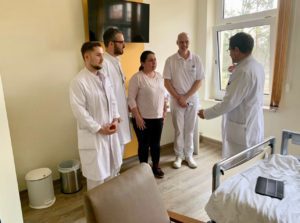Adult-Onset Still’s Disease (AOSD)
What is adult-onset Still’s disease (AOSD)?
Adult-onset Still’s disease is a rare condition that is characterized by episodes of high fevers, joint pain, and a salmon-colored rash that comes in periods of flare-ups and disperses in periods of remission. The disease can appear and disappear suddenly, arrive in only one episode, or have more frequent flare-ups in a span of several months. Because of the variability in these episodes, the progression of AOSD is difficult to predict. There is a pediatric form of Still’s disease known as systemic onset juvenile inflammatory arthritis.What causes adult-onset Still’s disease (AOSD)?
The cause of AOSD is still largely unknown, but people within the age groups of 15 to 25 and 36 to 46 are particularly at risk. Some doctors speculate that the condition may be related to certain antigens, which are the substances that cause the body to produce antibodies that fight infection.What are the symptoms of adult-onset Still’s disease (AOSD)?
An episode of AOSD usually presents itself with a fever that lasts for several days and increases at night. This fever is coupled with a quick-changing rash on the skin, which is similar to hives. In addition to these characteristic symptoms, the following may also occur:- Sore throat or inflamed and swollen lymph nodes
- Muscle or abdominal pain
- Pain associated with deep breathing
- Weight loss
How is adult-onset Still’s disease (AOSD) diagnosed?
Multiple tests need to be done to reach a conclusive diagnosis of AOSD because certain types of cancer and mononucleosis, such as Lyme disease, share many initial symptoms with the disease. Blood tests are extremely useful, as they can check the level of ferritin in the blood, which is often elevated in AOSD. Additional blood tests can evaluate joint inflammation, and radiology tests are used to examine the chest, liver, and spleen.What are the available treatments for adult-onset Still’s disease (AOSD)?
Even though there is no cure for AOSD, the condition is treatable. Usually, doctors will focus on addressing the arthritis that occurs in the disease by a short course of the drug, prednisone. If the prednisone fails to slow down the progression of AOSD arthritis, the following drugs that modulate the immune system may be helpful:- Tocilizumab
- Anakinra
- Methotrexate
- Etanercept
Where can I find more information on adult-onset Still’s disease (AOSD)?
Adult-Onset Still’s Disease (AOSD) Articles


Creating Perrarus: How Katharina Clark Aims to Uplift the Rare Disease Community (Pt. 2)
Jessica Lynn
June 3, 2022
Read More »

Creating Perrarus: How Katharina Clark Aims to Uplift the Rare Disease Community (Pt. 1)
Jessica Lynn
June 2, 2022
Read More »

Researchers Provide a Better Understanding of sJIA and Still’s Disease
Kendall Mason
October 21, 2020
Read More »

The First Treatment for Adult-Onset Still’s Disease Just Got FDA Approved
James Moore
June 19, 2020
Read More »

Drug Label Expanded in the UK for Treating Rare Inflammatory Diseases
James Moore
August 10, 2018
Read More »


The Director of “The Big Sick” Discusses His Wife’s Still’s Disease
James Moore
February 6, 2018
Read More »



